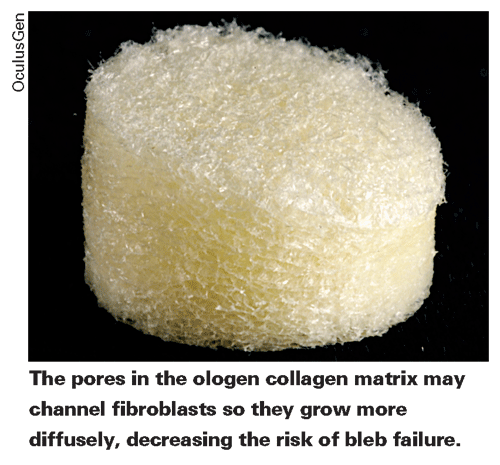After years of glaucoma surgery consisting of trabeculectomy, shunts and not much else, recently there has been an explosion in filtering procedures or adjuncts to make them better. OculusGen Biomedical, a company from 
Ologen itself is a matrix of collagen and chondroitin 6-sulfate that's 7 mm in diameter and 4 mm thick. It's 95-percent porous with pore sizes ranging from 20 to 200 µm. Robert Ritch, MD, chief of glaucoma at the New York Eye and Ear Infirmary, has worked on the initial papers using ologen in animal studies, reviewing the data and editing them. He is a consultant to OculusGen. "Ologen is designed to try to avoid the possible side effects of antifibrotic use such as hypotony and infection," he says. "After the trabeculectomy is completed, the surgeon puts the ologen on top of the scleral flap before the conjunctiva is closed. The thousands of pores in the ologen are designed to let fibroblasts grow in diffusely rather than coming in en masse and forming a scar that might lead to bleb failure. Instead it gives you a spongy, net-like bleb. The material then biodegrades over 30 to 60 days. At the end of that time, once the ologen is degraded enough, what you're left with is a fibroblast bleb."
In a multicenter, prospective study, 59 patients with refractory glaucoma underwent trabeculectomy with the use of adjunctive ologen in one eye. Preoperatively, the average intraocular pressure was 38.7 ±7.5 mmHg, and patients were on an average of 2.1 ±0.9 glaucoma medications. At nine months postop, the average IOP was 16.1 ±3.2 mmHg, a 58.3-percent reduction (p<0.05), and necessary medications had decreased to 0.3 ±0.2. There were no significant intraoperative or postoperative complications. (Chen HS, et al. IOVS 2007;48:ARVO E-Abstract 826)
Rimvydis Asoklis, MD, PhD, director of the
"As soon as we get the FDA's approval in the



